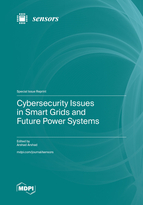Cybersecurity Issues in Smart Grids and Future Power Systems
A special issue of Sensors (ISSN 1424-8220). This special issue belongs to the section "Industrial Sensors".
Deadline for manuscript submissions: closed (30 September 2023) | Viewed by 43741
Special Issue Editor
Interests: high-voltage engineering; electricity markets; smart grids; power quality; power system design and operation
Special Issues, Collections and Topics in MDPI journals
Special Issue Information
Dear Colleagues,
The demand for a smart and intelligent power system is growing in tandem with the increased interest in renewable energy sources. This has resulted in the adoption of smart grids, which are electrical systems that leverage digital communication infrastructure. Smart grids have several advantages, including the potential to provide consumers with a continuous power supply, reduced line losses, enhanced renewable output and storage, consumer participation in electricity markets, and demand-side responsiveness. Future power systems, also known as smart grids, will rely more on renewable energy sources such as solar and wind, as well as storage. Power electronic converters are used in renewable energy generation and storage. Each converter/inverter manufacturer has its own algorithm for programming and optimising its hardware. Furthermore, to respond to any signal from the system operator, these converters rely on communication protocols. As a result, cyber-attacks on these smart converters/inverters are a concern. Despite the fact that numerous cyber–physical systems (CPS) have been presented, there is no universal CPS standard that can be employed with various types of converters. The main goal of this Special Issue is to give academics, researchers, and industry professionals an opportunity to highlight their current work and define future directions.
Topics of interest include, but are not limited to:
- Advanced converter control algorithms;
- Synthetic inertia and virtual synchronous machines;
- Cyber–physical systems for power systems;
- Power quality issues in future power systems;
- Lightweight encryption methods;
- Intrusion detection systems;
- Machine learning for cybersecurity;
- Secure and trustworthy operations in the industrial Internet of Things (IoT);
- Cybersecurity issues in the IoT
Dr. Arshad Arshad
Guest Editor
Manuscript Submission Information
Manuscripts should be submitted online at www.mdpi.com by registering and logging in to this website. Once you are registered, click here to go to the submission form. Manuscripts can be submitted until the deadline. All submissions that pass pre-check are peer-reviewed. Accepted papers will be published continuously in the journal (as soon as accepted) and will be listed together on the special issue website. Research articles, review articles as well as short communications are invited. For planned papers, a title and short abstract (about 100 words) can be sent to the Editorial Office for announcement on this website.
Submitted manuscripts should not have been published previously, nor be under consideration for publication elsewhere (except conference proceedings papers). All manuscripts are thoroughly refereed through a single-blind peer-review process. A guide for authors and other relevant information for submission of manuscripts is available on the Instructions for Authors page. Sensors is an international peer-reviewed open access semimonthly journal published by MDPI.
Please visit the Instructions for Authors page before submitting a manuscript. The Article Processing Charge (APC) for publication in this open access journal is 2600 CHF (Swiss Francs). Submitted papers should be well formatted and use good English. Authors may use MDPI's English editing service prior to publication or during author revisions.
Keywords
- advanced converter control algorithms
- synthetic inertia and virtual synchronous machines
- cyber–physical systems for power systems
- power quality issues in future power systems
- lightweight encryption methods
- intrusion detection systems
- machine learning for cybersecurity
- secure and trustworthy operations in the industrial Internet of Things (IoT)
- cybersecurity issues in the IoT







